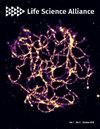FERM domain-containing proteins are active components of the cell nucleus.
IF 3.3
2区 生物学
Q1 BIOLOGY
引用次数: 0
Abstract
The FERM domain is a conserved and widespread protein module that appeared in the common ancestor of amoebae, fungi, and animals, and is therefore now found in a wide variety of species. The primary function of the FERM domain is localizing to the plasma membrane through binding lipids and proteins of the membrane; thus, for a long time, FERM domain-containing proteins (FDCPs) were considered exclusively cytoskeletal. Although their role in the cytoplasm has been extensively studied, the recent discovery of the presence and importance of cytoskeletal proteins in the nucleus suggests that FDCPs might also play an important role in nuclear function. In this review, we collected data on their nuclear localization, transport, and possible functions, which are still scattered throughout the literature, with special regard to the role of the FERM domain in these processes. With this, we would like to draw attention to the exciting, new dimension of the role of FDCPs, their nuclear activity, which could be an interesting novel direction for future research.含 FERM 结构域的蛋白质是细胞核的活性成分。
FERM 结构域是一种保守而广泛的蛋白质模块,出现在变形虫、真菌和动物的共同祖先中,因此现在广泛存在于各种物种中。FERM 结构域的主要功能是通过与膜上的脂质和蛋白质结合而定位到质膜上;因此,长期以来,含 FERM 结构域的蛋白质(FDCPs)被认为只具有细胞骨架功能。虽然它们在细胞质中的作用已被广泛研究,但最近发现细胞骨架蛋白在细胞核中的存在和重要性表明,FDCPs 也可能在核功能中发挥重要作用。在这篇综述中,我们收集了有关它们的核定位、运输和可能功能的数据,这些数据仍然散见于各种文献中,其中特别关注了 FERM 结构域在这些过程中的作用。在此,我们想提请大家注意 FDCPs 令人兴奋的新作用--它们的核活动,这可能是未来研究的一个有趣的新方向。
本文章由计算机程序翻译,如有差异,请以英文原文为准。
求助全文
约1分钟内获得全文
求助全文
来源期刊

Life Science Alliance
Agricultural and Biological Sciences-Plant Science
CiteScore
5.80
自引率
2.30%
发文量
241
审稿时长
10 weeks
期刊介绍:
Life Science Alliance is a global, open-access, editorially independent, and peer-reviewed journal launched by an alliance of EMBO Press, Rockefeller University Press, and Cold Spring Harbor Laboratory Press. Life Science Alliance is committed to rapid, fair, and transparent publication of valuable research from across all areas in the life sciences.
 求助内容:
求助内容: 应助结果提醒方式:
应助结果提醒方式:


